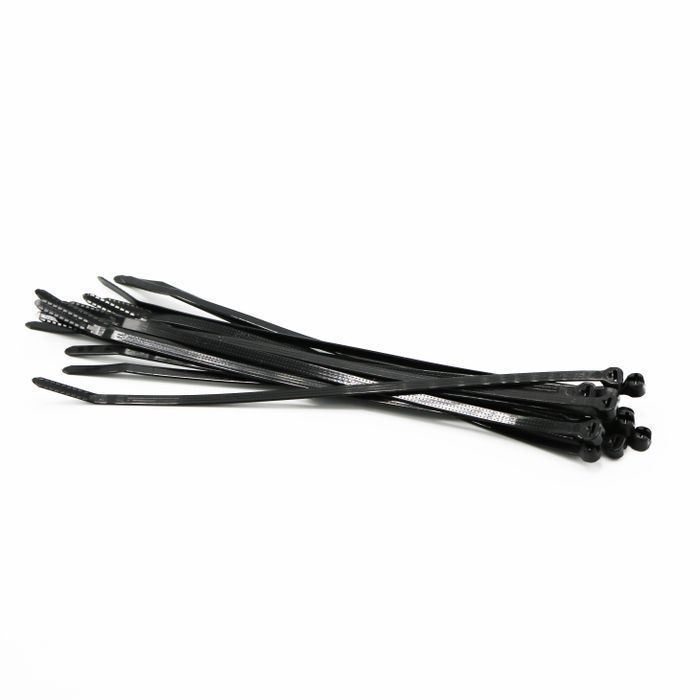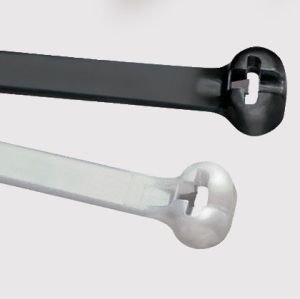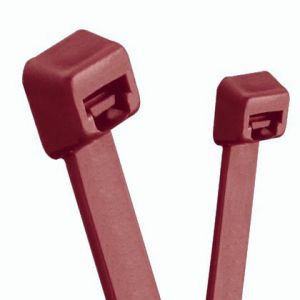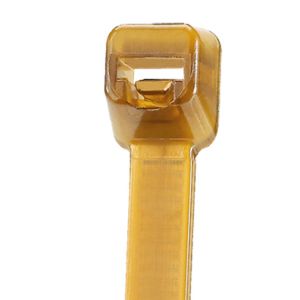Panduit Cable Ties

The heavy-hitters of cable ties
Panduit Cable Ties are available in Nylon 6.6 in black or neutral colors. The black is also UV resistant. The flammability rating is UL94V-2 and the cable tie is RoHS Compliant. All Panduit Cable Ties feature a unique curved tip that makes them easy to thread and put in place fast, with up to a 50-pound loop tensile strength depending on size.
Our Panduit Metal Barb Ties feature a stainless steel locking barb that will hold your tie down tight, and they are also made of Nylon 6.6. You can also chain these ties together to create a larger-diameter tie that won't loosen or slip. Likewise, they have a maximum loop tensile strength of 50 pounds depending on size of the tie.
Panduit Halar Plenum Rated Cable Ties come in red and are built tough for use in plenum spaces. Made of ECTFE, a fluoropolymer that is stronger, stiffer, and more stable than other types, it was designed to resist heat, flame, and corrosive materials. Its continuous use temperature is 302°F (150°C).
Finally, Panduit PEEK Cable Ties are made of Polyether ether ketone, hence the name. Weather and UV resistant, they are designed to hold up to chemical, high radiation, and/or high operating temperature environments. Their continuous use temperature is 500°F (260°C) and they approved for use by the Department of Defense.
A: Possibly, depending on your hand strength, but it's a lot easier and faster to use a tool to put on and tighten the ties. We recommend the Eclipse CP-385 Flush Cutting Adjustable Tension Cable Tie Gun, which can help you start threading the loose end of the tie, making it as tight as you need it to be, and then cleanly trimming the loose end.
It's particularly useful if you're going to be placing a lot of metal cable ties at once.
We have three models available: Regular duty for tensile loop strength between 18 and 50 pounds; Heavy Duty for 120 to 250 pounds; and Stainless Steel, for when you need that extra cutting power on the tie itself.
A: Like any other chemicals, it all depends on the combination and how strongly they're bound together. Table salt, for example, is made of two chemicals that are very dangerous on their own: Sodium and chlorine.
If they broke apart, the chlorine would become a dangerous gas and, on a humid day, the sodium would become quite reactive with the air. In water, it reacts to generate heat and melts rapidly, letting off highly flammable hydrogen gas and sodium hydroxide.
Fortunately, table salt is extremely unlikely to ever break apart.
Likewise, the polyether ether ketone in PEEK is very unlikely to spontaneously separate and, even then, the chemicals in it aren't necessarily that dangerous.
When you hear "ether," you probably think of surgical anesthetic, but that's because a collective term was applied in common parlance to one member of the group. Ethers as a whole are a specific set of organic compounds, but only a select few of them were ever effective as or used for surgical anesthesia, particularly diethyl ether.
Polyethylene glycol, for example, is an ether, but it has many uses, including skin creams, toothpaste, and laxatives, and is safe for human consumption.
If ketone sounds familiar, you're probably thinking of the keto diet, and they are connected, because ketones are a class of chemicals that include sugars like fructose and are produced in the human body by the liver.
The process of ketosis just produces these sugars from body fat to use for energy instead of carbs. The only problem is if ketone levels become too high, but this tends to only be an issue with diabetes.
So don't worry — that PEEK isn't coming apart chemically in your hands, either.









